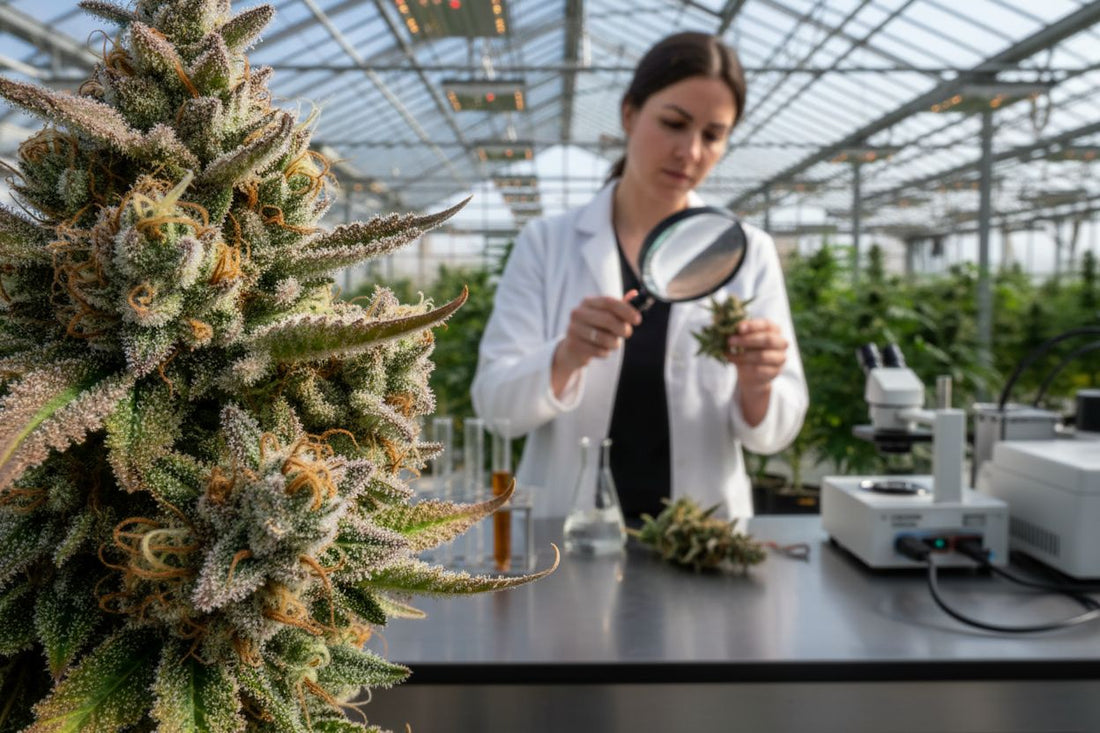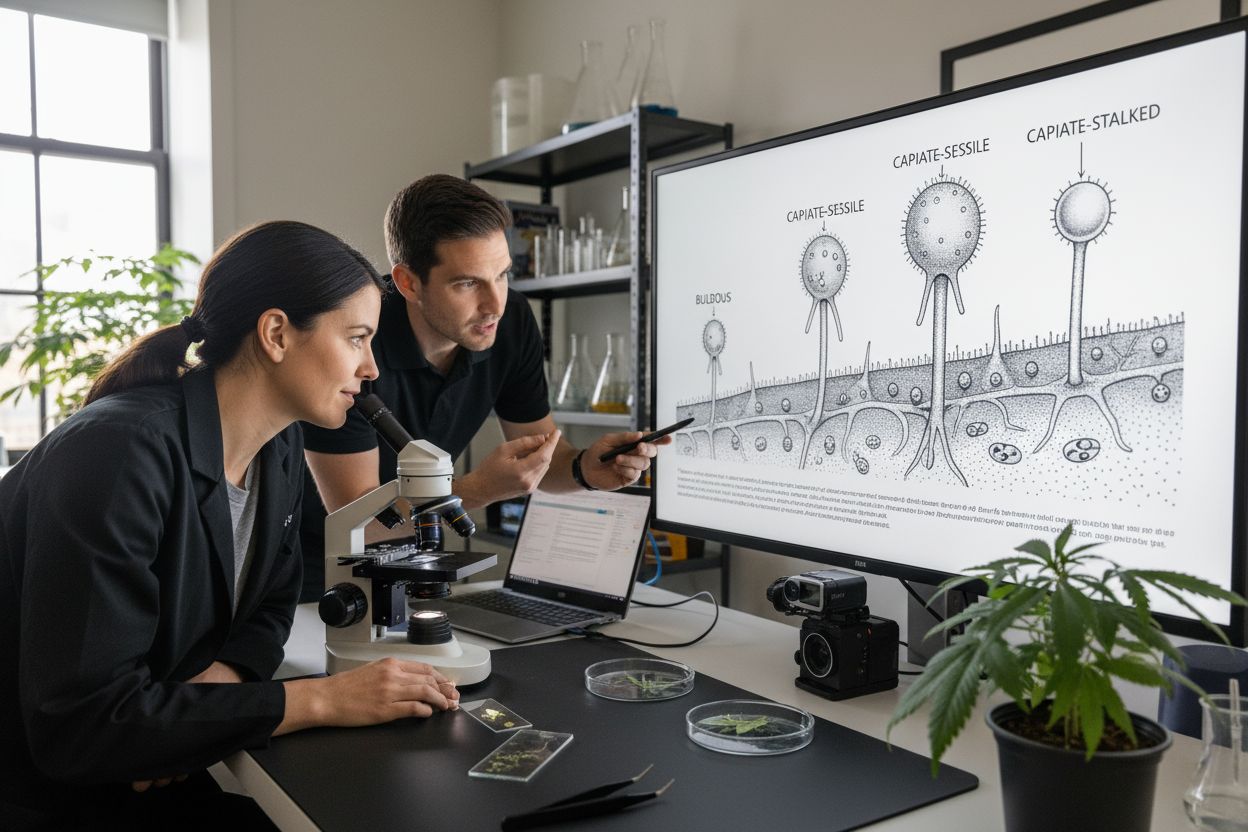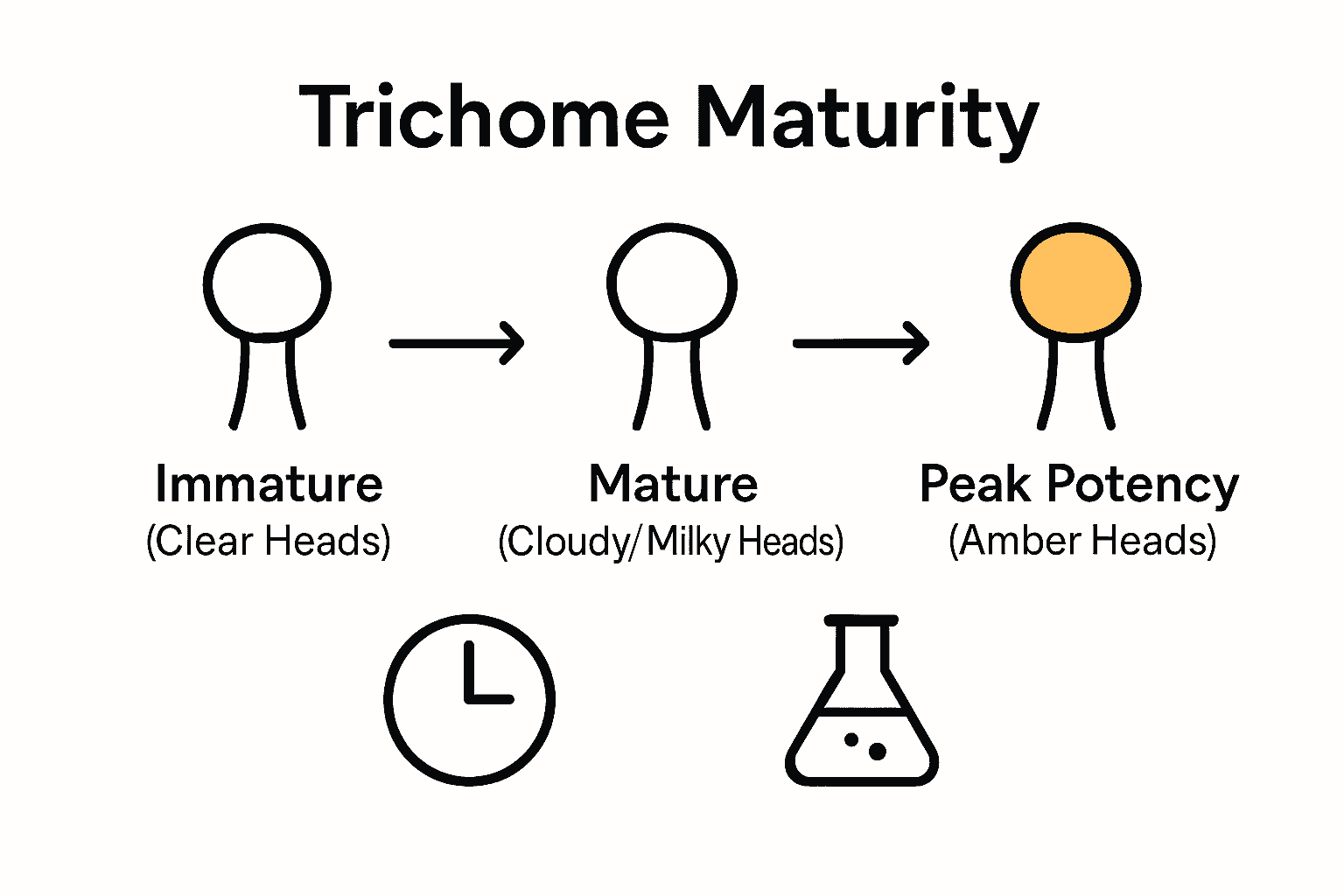What Are Cannabis Trichomes? Complete Guide
Written by Trevor

Did you know that a single cannabis flower can contain thousands of microscopic trichomes, each acting as a tiny chemical factory? These structures aren’t just eye-catching—they hold the key to the plant’s potency, aroma, and unique effects. While trichomes protect cannabis from harsh environments and predators, their true magic occurs inside, where cannabinoids and terpenes are produced and carefully stored, shaping the distinct qualities of every strain.
Key Takeaways
| Point | Details |
|---|---|
| Trichome Functions | Trichomes are vital for cannabinoid and terpene production, acting as the plant’s defense and chemical synthesis centers. |
| Types of Trichomes | Cannabis features three primary types of glandular trichomes, with capitate-stalked trichomes being the most significant for potency due to their high cannabinoid content. |
| Quality Indicators | Trichome maturity, genetic background, and harvest timing are crucial for determining the quality and potency of cannabis products. |
| Safety and Legal Considerations | Rigorous testing is essential for trichome-derived products to ensure safety, with comprehensive screening for potency and contaminants being mandatory for consumer protection. |
Table of Contents
- Defining Cannabis Trichomes And Their Functions
- Types Of Trichomes On Cannabis Plants
- Trichomes’ Role In Potency And Effects
- Harvesting, Extraction, And Product Quality
- Legal And Safety Considerations With Trichomes
Defining Cannabis Trichomes And Their Functions
Trichomes are microscopic, hair-like structures that grow on cannabis plants, serving as nature’s tiny chemical factories. According to research from the Journal of Cannabis Research, these fascinating structures form primarily on the bract tissues of female Cannabis sativa plants and play a crucial role in cannabinoid and terpene production.
There are three primary types of glandular trichomes in cannabis, each with unique characteristics:
- Bulbous Trichomes: The smallest and least significant type
- Capitate-Sessile Trichomes: Slightly larger, with a broader base
- Capitate-Stalked Trichomes: The most prominent and cannabinoid-rich structures
Research from the National Center for Biotechnology Information highlights that capitate-stalked trichomes are the most important, producing the greatest quantity of cannabinoids. What makes them special is their complex structure: these trichomes have a multi-cellular secretory disk that synthesizes and stores precious cannabinoids and terpenes. Their development is dynamically influenced by the plant’s age and genetic background, meaning that the quantity and quality of trichomes can vary significantly between different cannabis strains.
Think of trichomes as the plant’s defense mechanism and chemical powerhouse. They protect cannabis from environmental stressors like UV radiation, extreme temperatures, and potential predators while simultaneously creating the complex chemical profile that makes each cannabis strain unique. Read more about the intricate world of cannabis plant chemistry.
Types Of Trichomes On Cannabis Plants
Cannabis plants are home to a fascinating array of trichome types, each with unique characteristics and functions. According to research from Weedmaps, cannabis trichomes are primarily categorized into three distinct glandular varieties that differ dramatically in size, structure, and cannabinoid production.
The Three Primary Trichome Types
-
Bulbous Trichomes:
- The smallest and most widespread type
- Microscopic structures scattered across the plant’s surface
- Minimal cannabinoid production
-
Capitate-Sessile Trichomes:
- Slightly larger than bulbous trichomes
- Mushroom-like heads with more developed secretory cells
- More abundant across cannabis plant tissues
-
Capitate-Stalked Trichomes:
- The most developed and significant trichome type
- Mature later in the plant’s growth cycle
- Produce the highest concentration of cannabinoids and terpenes
Research from the International Journal of Molecular Sciences confirms that female cannabis flowers predominantly feature these three glandular trichome types. Interestingly, the plants also possess non-glandular structures like cystolithic hairs, which do not contribute to cannabinoid biosynthesis. Explore more about the intricate world of THCA-rich cannabis strains to understand how these trichome variations impact overall plant chemistry and potential effects.
Here’s a comparison of the three primary cannabis trichome types:

| Trichome Type | Size & Structure | Location on Plant | Cannabinoid Production |
|---|---|---|---|
| Bulbous | Smallest Simple structure |
Scattered across surface | Minimal |
| Capitate-Sessile | Slightly larger Mushroom-shaped |
Widespread on bract tissues | Moderate |
| Capitate-Stalked | Largest Stalked, complex heads |
Predominant on female flowers | Highest Rich in cannabinoids |
Trichomes’ Role In Potency And Effects
Cannabinoid production is the magical process that transforms cannabis from a simple plant into a powerhouse of potential effects. According to research from the National Center for Biotechnology Information, stalked glandular trichomes are the primary architects of cannabis potency, with their complex morphological structure directly influencing the plant’s chemical composition.
The Chemical Synthesis Process
Inside these microscopic structures, a fascinating biochemical dance occurs. Research reveals that cannabinoids are synthesized through an intricate enzyme-mediated process where terpene and phenol precursors combine within specialized secretory cavities. This means that:
- Mature trichomes contain the highest concentration of active compounds
- Drug-type strains accumulate higher THC levels
- Fiber strains tend to concentrate more CBD
The number of secretory disk cells in capitate-stalked trichomes becomes a critical factor in determining overall cannabinoid output. Essentially, more sophisticated trichome structures translate to more complex and potentially more potent cannabis products. The variations in trichome development can explain why two seemingly similar cannabis strains might produce dramatically different effects.
Think of trichomes as tiny chemical factories, each with its own unique production capabilities. Their maturity, genetic background, and environmental conditions all play crucial roles in determining the final cannabinoid profile. Learn more about understanding cannabis potency in our comprehensive guide, which delves deeper into how these microscopic structures influence your cannabis experience.
Harvesting, Extraction, And Product Quality
Trichome preservation is the critical factor that separates exceptional cannabis products from ordinary ones. Research from the National Center for Biotechnology Information reveals that the distribution, maturity, and morphology of trichomes are pivotal in determining the final product’s quality and consistency.
Key Extraction and Quality Considerations
The harvesting window is incredibly narrow and sensitive. Factors that impact trichome quality include:
- Plant Genetics: Different strains produce varying trichome profiles
- Developmental Stage: Trichome maturity directly influences cannabinoid concentration
- Harvest Timing: Peak potency occurs when trichomes are at maximum maturity

Traditional extraction methods like mechanical dry-sifting and charas techniques focus on carefully removing trichome resin. According to historical research on hashish production, these methods can produce kief with astonishingly high THC concentrations—up to 60%—demonstrating the incredible potency locked within these microscopic structures.
The art of cannabis extraction is essentially a delicate dance of preserving these fragile trichomes. Environmental conditions, handling techniques, and timing all play crucial roles in maintaining the integrity of these cannabinoid-rich structures. Some extraction methods are more gentle, ensuring minimal degradation of the valuable compounds, while others might compromise the delicate trichome architecture. Learn more about cannabis quality indicators that can help you make better choices and understand the nuanced world of cannabis product quality.
Legal And Safety Considerations With Trichomes
Cannabis product safety is paramount in the modern cannabis market, with trichome-derived products requiring rigorous testing and careful consideration. Cannabis product testing labs play a critical role in ensuring consumer protection by analyzing extracts and edibles for potential risks and quality markers.
Key Safety Screening Parameters
Comprehensive testing of trichome-based products involves multiple crucial screenings:
- Potency Testing: Verifying actual cannabinoid concentration
- Contaminant Screening: Detecting potential hazardous substances
- Microbial Analysis: Checking for harmful bacteria or mold
The safety screening process typically examines these critical areas:
- Heavy Metal Contamination
- Pesticide Residue
- Solvent Traces
- Microbial Presence
- Mold and Fungal Growth
Consumers must understand that not all cannabis products are created equal. The complexity of trichome extraction means that without proper testing, products could potentially contain dangerous compounds that are invisible to the naked eye. Professional laboratories use sophisticated techniques to ensure that trichome-rich products meet stringent safety standards.
Navigating the legal landscape of cannabis products requires awareness and caution. Regulations can vary significantly between jurisdictions, making it crucial for consumers to stay informed about local laws and product requirements. Learn more about the legal considerations when handling cannabis products to ensure you’re always on the right side of the law.
Experience Potency That Starts With Trichomes: Shop Premium THCa Flower Today
You have discovered just how important trichomes are to cannabis strength, effects, and overall quality. If you are searching for flower where these cannabinoid-rich glands are fully preserved and valued, the THCa Prestige Vault at California Blendz is the perfect next step. Our exclusive collection features hand-picked, high-potency THCa flower grown in California’s legendary Emerald Triangle—exactly where nature produces the richest trichomes and most authentic flavors.

Do not settle for flower products with questionable origins or uncertain lab results. Every item on California Blendz is third-party tested for potency and purity and grown sustainably for an unmatched experience. Browse our THCa 50/50 Hybrid lineup and discover how transparent sourcing and premium trichome preservation can make a real difference for you. Start shopping today and feel the results that true quality brings.
Frequently Asked Questions
What are cannabis trichomes?
Trichomes are microscopic, hair-like structures found on cannabis plants, mainly on the bract tissues of female plants. They function as chemical factories, producing cannabinoids and terpenes that contribute to the plant’s potency and unique chemical profile.
What are the different types of trichomes in cannabis?
There are three primary types of glandular trichomes: Bulbous trichomes (small and few cannabinoids), Capitate-sessile trichomes (larger with moderate cannabinoid production), and Capitate-stalked trichomes (the largest, complex structures responsible for the highest concentration of cannabinoids and terpenes).
How do trichomes affect the potency of cannabis?
Trichomes are crucial for cannabinoid production, with capitate-stalked trichomes being the primary architects of cannabis potency. Their maturity and structural complexity directly influence the concentration of cannabinoids like THC and CBD within the cannabis product.
Why is trichome preservation important during cannabis extraction?
Trichome preservation is vital for maintaining the quality and potency of cannabis products. Proper harvesting and extraction methods help protect these delicate structures, ensuring that the cannabinoids and terpenes remain intact and impactful in the final products.
Recommended
- The Importance of Trichomes in Cannabis Plants: A Comprehensive Guide – California Blendz
- Demystifying THCA Flower: Is it Hemp or Something Else? – California Blendz
- Unlocking the Secrets: How is THCA Flower Made and What Makes it Uniqu – California Blendz
- Unlocking the Power of THCA-Rich Strains: A Comprehensive Guide – California Blendz








